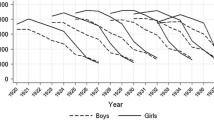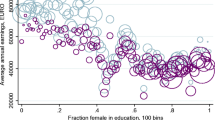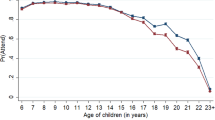Abstract
This paper empirically investigates whether the quantity deficit in the children of the mother’s preferred gender is compensated through their favorable treatment in terms of investment in schooling (what we call a compensating hypothesis) in an environment where schooling opportunities are limited. We use data from siblings in two rounds of the demographic and health surveys of Ethiopia for empirical analysis. Using the gender ratio of the mother’s own siblings and the birth of same sex twins as instruments for gender ratio gap, we estimate binary choice models with clustering for school attendance using generalized instrumental variable techniques with interactive instruments. Our empirical evidence appears to be consistent with the compensating hypothesis that the larger the excess of actual proportion of girls over the mother’s desired proportion, the smaller a girl’s chance of attending school and the bigger a boy’s chance of attending school will be.
Similar content being viewed by others
Notes
Ultrasound and other visual inspection technologies that are used to identify gender of the fetus are unavailable in rural Ethiopia where 85 % of the people live and most of the towns.
We were not able to test the compensating hypothesis under the common assumption of unified preferences for the mother and father, who may have different and contradicting preferences in practice. Failure to reject the compensating hypothesis in the data based on just the mother’s gender preferences may thus be taken as an indication that the mother has enough bargaining power to enforce her preferences when it comes to child schooling decisions.
Ethiopia represents an ideal context for empirically examining the research question raised in this paper because of large number of children per mother and limited schooling opportunities for children, which makes observation of differential schooling outcomes between children relatively easy.
Controlling for family wealth status is important because fertility preferences could differ by wealth class and its omission may bias our estimates for the key coefficients.
We avoided probit model for this dichotomous outcome variable because implementation techniques for interactive instruments are not readily available in a non-linear framework. However, linear approximations of such models provide consistent estimates of the average treatment effects (Angrist and Krueger 2001).
In the demographic and health surveys that are used for analysis in this paper, the question about the desired gender mix of children was asked retroactively by asking the mother how many boys, girls, or children of any sex would she like to have had if she could go back to the time she did not have any children.
The data were provided by the U.S. Agency for International Development which is the financial sponsor of all the Demographic and Health Surveys.
Considering the marginal effect of a one standard deviation (0.21) increase in the gender ratio gap doesn’t seem to be unreasonable in our data where the average number of children per couple is about five. For example, if a mother who would prefer to have equal number of boys and girls currently has two boys and two girls but gives birth to an additional girl, her gender ratio gap would increase by 0.2 (by about one standard deviation).
Some evidence of the effects of such possible conflicting preferences on investment in nutrition for boys and girls in Ethiopia is reported in Gibson (2008).
References
Angrist, J. D., & Krueger, A. (2001). Instrumental variables and the search for identification: from supply and demand to natural experiments. Journal of Economic Perspectives, 15(4), 69–85.
Becker, G. S. (1960). An economic analysis of fertility. In Demographic and Economic Change in Developed Countries. Universities - National Bureau Conference Series, No.11. Princeton: Princeton University Press.
Becker, G. S. (1991). A treatise on the family, enlarged edition. Cambridge and London: Harvard University Press.
Becker, G. S., & Lewis, G. H. (1973). On the interaction between quality and quantity of children. Journal of Political Economy, 84, S279–S288.
Becker, G. S., & Tomes, N. (1976). Child endowments and the quality and quantity of children. Journal of Political Economy, 82, S143–S162.
Black, S. E., Devereux, P. J., & Salvanes, K.J. (2007). Small family, smart family? The family size and IQ scores of young men. NBER Working Paper No. 13336.
Butcher, K. F., & Case, A. (1994). The effect of sibling sex composition on women’s education and earnings. Quarterly Journal of Economics, 109(3), 531–563.
Garg, A., & Morduch, J. (1998). Siblings rivalry and the gender gap: evidence from child health outcomes from Ghana. Journal of Population Economics, 11, 461–493.
Gibson, M. A. (2008). Does investment in the sexes differ when fathers are absent? Sex-biased infant survival and child growth in rural Ethiopia. Human Nature, 19(3), 263–276.
Hauser, R. M., & Kuo, D. H.-H. (1998). Does the gender composition of the sibships affect women’s educational attainment? The Journal of Human Resources, 33(3), 644–657.
Kaestner, R. (1997). Are brothers really better? Sibling sex composition and educational attainment revisited. The Journal of Human Resources, 32(2), 250–284.
Morduch, J. (2000). Sibling rivalry in Africa. The American Economic Review, Papers and Proceedings of the One Hundred Twelfth Annual Meeting of the American Economic Association, 90(2), 405–409.
Paris, W. L., & Willis, R. J. (1993). Daughters, education, and family budgets: Taiwan experiences. The Journal of Human Resources, 28, 863–898.
Rosenzweig, M. R., & Wolpin, K. I. (1980). Testing the quantity-quality fertility model: the use of twins as a natural experiment. Econometrica, 48(1), 227–240.
Stock, J., Wright, J., & Yogo, M. (2002). A Survey of weak instruments and weak identification in generalized method of moments. Journal of the American Statistical Association, 20(4), 518–529.
Wooldridge, J. M. (1997). On two stage least squares estimation of the average treatment effect in a random coefficient model. Economics Letters, 56, 129–133.
Wooldridge, J. M. (2003). Further results on instrumental variables estimation of average treatment effects in the correlated random coefficient model. Economics Letters, 79, 185–191.
Author information
Authors and Affiliations
Corresponding author
Additional information
We thank Barry Hirsch, Erdal Tekin, and Jose Canals-Cerda for useful suggestions. We would also like to acknowledge the U.S. Agency for International Development for providing us with the data used in this paper. We are solely responsible for interpretation of the results and all the remaining errors.
Electronic supplementary material
Below is the link to the electronic supplementary material.
ESM 1
(DOCX 48 kb)
Rights and permissions
About this article
Cite this article
Tesfu, S.T., Gurmu, S. Mother’s Gender Preferences and Child Schooling in Ethiopia. Atl Econ J 41, 265–277 (2013). https://doi.org/10.1007/s11293-013-9366-2
Published:
Issue Date:
DOI: https://doi.org/10.1007/s11293-013-9366-2
Keywords
- Gender preferences
- Compensating hypothesis
- Child schooling
- Human capital
- Generalized instrumental variables estimation




